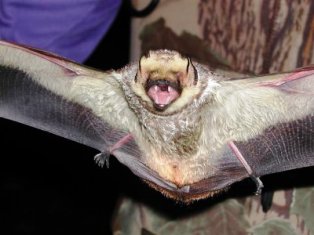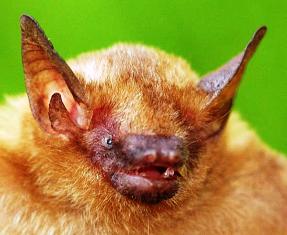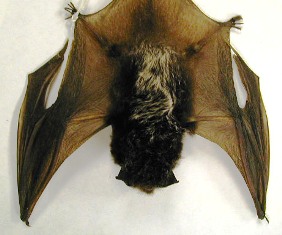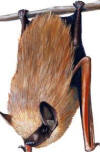Florida Bats- Nature's Insect Repellant
Found throughout the state, the most common species
of solitary bat found in southern Florida is the northern yellow bat.
A large, yellowish-brown bat with short ears and long, silky fur;
These bats are larger than the red and Seminole bats. Clumps of Spanish
moss make good daytime roosting places for northern yellow bats. Small
groups of males or slightly larger groups of females are often found
roosting together in forested areas near a permanent source of water.
They are seldom found roosting in houses or other manmade structures.
They feed over open spaces: they are seen over golf courses, beaches,
and along the edges of ponds, hunting for
mosquitoes, flies, and other insect prey. Barn
owls are known to prey on them. Unlike most other
Lasiurus bats, they have only two nipples, and if a female gives
birth to more than two offspring, usually only two survive. Young are
born in May or June and are flying by June or July.
The silvered-haired bat is a medium-size bat. It's dark brown-black
hairs are tipped with silver giving it an icy appearance. The
silver-tipped hairs do not extend to the face or neck. Their ears are
short, rounded and without fur. The silver-haired bats are migratory,
and sometimes migrate in groups. There are several records of groups of
weary bats descending upon ships at sea. Some bats netted during summer
months and banded were recaptured over 100 miles away! A typical day
roost for the silver-haired bat is the space behind a piece of loose
bark on a tree. Individuals have also been found in
woodpecker holes and on bird's nests. During migration they may be
encountered in a wide variety of other shelters. Although they may
appear in any kind of building, they favor open sheds, garages, and
outbuildings rather than enclosed attics. They frequently rest in a pile
of slabs, lumber, railroad ties, or fence posts, especially when
migrating through the prairies where shelters are scarce.
The Eastern Pipistrelle, Florida's smallest bat,
is a dainty yellowish to light-brown colored bat found throughout most
of the state. Its individual hairs are tri-colored, giving the
appearance of rings when the fur is blown on. Even though considered to
be solitary in nature, Eastern Pipistrelles form small maternity
colonies, usually no greater than 20 individuals. Summer colony roost
sites include hollow trees, the underside of tree bark, manmade
structures, the underside of shingles and Spanish moss. Colonies are
often in the open and are exposed to more light than other bat species
are exposed to. Eastern Pipistrelle's often use caves as winter roosts.
They are one of the first to come out at night and are slow flyers with
a somewhat erratic flight pattern. Because of their small size, Eastern
Pipistrelles are sometimes mistaken for moths. Adults weigh between 4
to 10 grams (or less than a half an ounce) and reach a forearm length of
1 to 1 1/2 inches. They are easily distinguished from other similar
species by their tri-colored fur. Pipistrelles are nicknamed butterfly
bats for their distinctive moth-like flight pattern.





Comments
Post a Comment